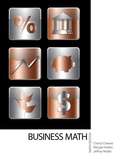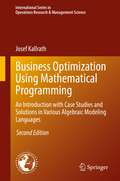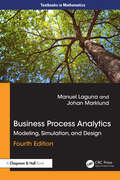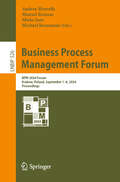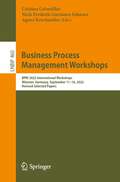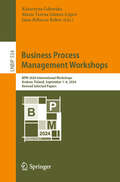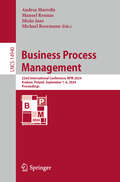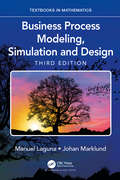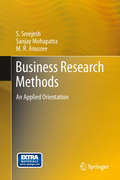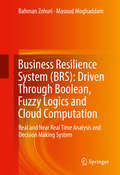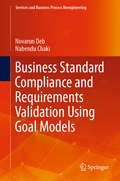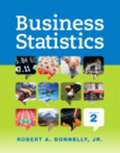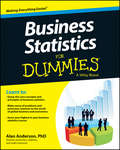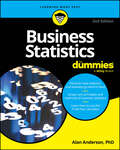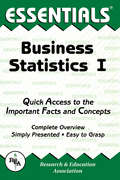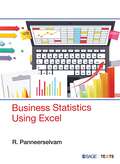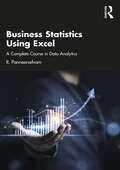- Table View
- List View
Business Math: The Mathematics of Money
by Timothy J. BiehlerThe Mathematics of Money (3rd edition) covers general financial principles and the mathematical tools needed to understand and make use of those principles. <p><p> The Mathematics of Money is intended for use in college-level business and financial mathematics courses, and it does not assume that students have any particular level of math experience other than the ability to do basic arithmetic calculations with the aid of a calculator.
Business Mathematics
by Cheryl Cleaves Margie Hobbs Jeffrey NobleFor courses in business mathematics, personal finance, or small business management. <p><p> Empowers your students to manage personal finances <p> Business Math is a practical and thorough guide for students and small business owners to learn how to manage personal and business finances. The book was written on the premise that everyone needs to understand how to manage money, offering a rare deep dive into topics not always taught in class. A conversational tone, real world examples, and case studies keep complicated topics understandable and engaging. <p> The 9th Edition starts off by reviewing basic math. It then dives into topics relevant for any career such as mortgages, banking, interest, consumer credit, and more. It also touches on important topics for business owners including payroll, markup, markdown, trade discounts, business statistics and more, as well as topics for those close to business recordkeeping like government agencies, lending agencies, depreciation, inventory and financial statements.
Business Mathematics (Second Edition)
by Temoleon G. Rousos Walter H. Lange Robert D. Mason Jean B. RogersHigh School business math textbook.
Business Mathematics (Second Edition)
by Temoleon G. Rousos Walter H. Lange Robert D. Mason Jean B. RogersHigh School business math textbook.
Business Optimization Using Mathematical Programming: An Introduction with Case Studies and Solutions in Various Algebraic Modeling Languages (International Series in Operations Research & Management Science #307)
by Josef KallrathThis book presents a structured approach to formulate, model, and solve mathematical optimization problems for a wide range of real world situations. Among the problems covered are production, distribution and supply chain planning, scheduling, vehicle routing, as well as cutting stock, packing, and nesting. The optimization techniques used to solve the problems are primarily linear, mixed-integer linear, nonlinear, and mixed integer nonlinear programming. The book also covers important considerations for solving real-world optimization problems, such as dealing with valid inequalities and symmetry during the modeling phase, but also data interfacing and visualization of results in a more and more digitized world. The broad range of ideas and approaches presented helps the reader to learn how to model a variety of problems from process industry, paper and metals industry, the energy sector, and logistics using mathematical optimization techniques.
Business Process Analytics: Modeling, Simulation and Design (Textbooks in Mathematics)
by Manuel Laguna Johan MarklundThe fourth edition of this widely used textbook offers a new perspective. Previously titled Business Process Modeling, Simulation and Design, as the new title suggests, this book is about analytical business process modeling and design. However, this new edition introduces analytics to the title and to the presentation.The main objective of this book is to provide students with a comprehensive understanding of the multitude of analytical tools that can be used to model, analyze, understand, and ultimately design business processes.The most flexible and powerful of these tools, although not always the most appropriate, is discrete-event simulation. The wide range of approaches covered in this book include graphical flowcharting tools, deterministic models for cycle time analysis and capacity decisions, and analytical queuing methods, as well as machine learning.The authors focus on business processes as opposed to just manufacturing processes or general operations management problems and emphasize on simulation modeling using state-of-the-art commercial simulation software.Business Process Analytics: Modeling, Simulation, and Design can be thought of as a hybrid between traditional books on process management, operations management, and simulation. The growing interest in simulation-based tools suggests that an understanding of simulation modeling, its potential as well as its limitations for analyzing and designing processes, is of key importance to students looking for a future career in operations management.Changes from the previous edition include the following: New section on data-driven process improvement (with data visualization) Added a subsection of control charts to the 6-sigma section Replaced business process reengineering with business process management Updated all text, figures, examples, and exercises to ExtendSim10 (current version) More coverage on design of experiments More coverage of machine learning and neural networks
Business Process Management Forum: BPM 2024 Forum, Krakow, Poland, September 1–6, 2024, Proceedings (Lecture Notes in Business Information Processing #526)
by Michael Rosemann Andrea Marrella Manuel Resinas Mieke JansThis book constitutes the proceedings of the BPM Forum held at the 22nd International Conference on Business Process Management, BPM 2024, which took place in Krakow, Poland, in September 2024. The BPM Forum hosts innovative research which has a high potential of stimulating discussions. The papers selected for the forum are expected to showcase fresh ideas from exciting and emerging topics in BPM, even if they are not yet as mature as the regular papers at the conference. The 21 papers included in this book were carefully reviewed and selected from a total of 144 submissions to the conference. The papers were organized in research tracks on foundations, engineering, and management.
Business Process Management Forum: BPM 2025 Forum, Seville, Spain, August 31 – September 5, 2025, Proceedings (Lecture Notes in Business Information Processing #564)
by Hajo A. Reijers Cristina Cabanillas Arik Senderovich Irene VanderfeestenThis book constitutes the proceedings of the BPM Forum held at the 23rd International Conference on Business Process Management, BPM 2025, which took place in Seville, Spain, during September 2025. The BPM Forum hosts innovative research which has a high potential of stimulating discussions. The papers cover a diverse and timely set of topics, reflecting the evolving socio-technical and AI-enhanced landscape of BPM. They explore themes such as the use of large language models in process monitoring and predictive analytics, RPA-induced technostress, blockchain-based compliance and documentation systems, process similarity and fairness in decision making, as well as new methods for model orchestration and simulation. The 23 papers included in this book were carefully reviewed and selected from a total of 132 submissions to the conference. They were organized in research tracks on foundations, engineering, and management.
Business Process Management Workshops: BPM 2022 International Workshops, Münster, Germany, September 11–16, 2022, Revised Selected Papers (Lecture Notes in Business Information Processing #460)
by Agnes Koschmider Cristina Cabanillas Niels Frederik Garmann-JohnsenThis book constitutes revised papers from the International Workshops held at the 20th International Conference on Business Process Management, BPM 2022, in Münster, Germany, during September 11-15, 2022. Papers from the following workshops are included:· 6th International Workshop on Artificial Intelligence for Business Process Management (AI4BPM 2022)· 6th International Workshop on Business Processes Meet Internet-of-Things (BP-Meet-IoT 2022)· 18th International Workshop on Business Process Intelligence (BPI 2022)· 2nd International Workshop on Business Process Management and Routine Dynamics (BPM&RD 2022)· 14th International Workshop on Social and Human Aspects of Business Process Management (BPMS2 2022) · 1st International Workshop on Data-Driven Business Process Optimization (BPO 2022) · 10th International Workshop on DEClarative, DECision and Hybrid approaches to processes (DEC2H 2022) · 1st International Workshop on Natural Language Processing for Business Process Management (NLP4BPM 2022) Each of the eight workshops focused on particular aspects of business process management. Overall, after a thorough review process, there were 23 full and 3 short papers selected from a total of 51 submissions. Only one of the short papers is included in the proceedings.
Business Process Management Workshops: BPM 2023 International Workshops, Utrecht, The Netherlands, September 11–15, 2023, Revised Selected Papers (Lecture Notes in Business Information Processing #492)
by Jochen De Weerdt Luise PufahlThis book constitutes revised papers from the International Workshops held at the 21st International Conference on Business Process Management, BPM 2023, in Utrecht, The Netherlands, during September 2023.Papers from the following workshops are included:• 7th International Workshop on Artificial Intelligence for Business Process Management (AI4BPM 2023)• 7th International Workshop on Business Processes Meet Internet-of-Things (BP-Meet-IoT 2023)• 19th International Workshop on Business Process Intelligence (BPI 2023)• 16th International Workshop on Social and Human Aspects of Business Process Management (BPMS2 2023)• 2nd International Workshop on Data-Driven Business Process Optimization (BPO 2023)• 11th International Workshop on Declarative, Decision and Hybrid Approaches to Processes (DEC2H 2023)• 1st International Workshop on Digital Twins for Business Processes (DT4BP 2023)• 1st International Workshop on Formal Methods for Business Process Management (FM-BPM 2023) • 2nd International Workshop on Natural Language Processing for Business Process Management (NLP4BPM 2023)• 1st International Workshop on Object-Centric Processes from A to Z (OBJECTS 2023)• 3rd International Workshop on Change, Drift, and Dynamics of Organizational Processes (ProDy 2023) Each of the workshops focused on particular aspects of business process management. Overall, after a thorough review process, 42 full papers were selected from a total of 86 submissions.
Business Process Management Workshops: BPM 2024 International Workshops, Krakow, Poland, September 1–6, 2024, Revised Selected Papers (Lecture Notes in Business Information Processing #534)
by María Teresa Gómez-López Jana-Rebecca Rehse Katarzyna GdowskaThis book constitutes revised papers from the International Workshops held at the 22nd International Conference on Business Process Management, BPM 2024, in Krakow, Poland, during September 2024. Each of the workshops focused on particular aspects of business process management. Overall, after a thorough review process, 28 full papers and 2 short papers were selected from a total of 64 submissions. Papers from the following workshops are included: 8th International Workshop on Artificial Intelligence for Business Process Management (AI4BPM 2024) 3rd International Workshop on Data-Driven Business Process Optimization (BPO 2024) 8th International Workshop on Business Processes Meet Internet-of-Things (BP-Meet-IoT 2024) 17th International Workshop on Social and Human Aspects of Business Process Management (BPMS2 2024) 3rd International Workshop on Natural Language Processing for Business Process Management (NLP4BPM 2024) International Workshop on Object-centric Processes from A to Z (OBJECTS 2024) 2nd International Workshop on Change, Drift, and Dynamics of Organizational Processes (ProDy 2024) 1st International Workshop on Managing Process Innovation and Value Creation in the Era of Digital Transformation (Innov8BPM 2024)
Business Process Management: 22nd International Conference, BPM 2024, Krakow, Poland, September 1–6, 2024, Proceedings (Lecture Notes in Computer Science #14940)
by Michael Rosemann Andrea Marrella Manuel Resinas Mieke JansThis book constitutes the refereed proceedings of the 22nd International Conference on Business Process Management, BPM 2024, which took place in Krakow, Poland, in September 2024. The 29 full papers included in this book were carefully reviewed and selected from 144 submissions. They were organized in topical sections as follows: Foundations; Engineering; and Management. .
Business Process Modeling, Simulation and Design (Textbooks in Mathematics)
by Manuel Laguna Johan MarklundBusiness Process Modeling, Simulation and Design, Third Edition provides students with a comprehensive coverage of a range of analytical tools used to model, analyze, understand, and ultimately design business processes. The new edition of this very successful textbook includes a wide range of approaches such as graphical flowcharting tools, cycle time and capacity analyses, queuing models, discrete-event simulation, simulation-optimization, and data mining for process analytics. While most textbooks on business process management either focus on the intricacies of computer simulation or managerial aspects of business processes, this textbook does both. It presents the tools to design business processes and management techniques on operating them efficiently. The book focuses on the use of discrete event simulation as the main tool for analyzing, modeling, and designing effective business processes. The integration of graphic user-friendly simulation software enables a systematic approach to create optimal designs.
Business Research Methods: An Applied Orientation
by Sanjay Mohapatra S Sreejesh M R AnusreeSince research is best learned by doing, this book emphasizes a hands-on, do-it yourself approach. The readers have many opportunities to see how business researches affect and support management decision. The book used a case study approach for all the chapters with interactive videos. The book gave emphasis to quantitative data analysis using a software program, IBM SPSS 20.0. The data analysis chapters illustrate in detail each step in running the software programs. The software programs files are provided for all data sets: outputs, demonstration movies, and screen captures are on the Website. This book provides students most extensive help available to learn quantitative data analysis using SPSS. Thus, the authors prepared this textbook and all the additional materials to help the students to understand the functional principles of business research and how to apply them in real-life situations.
Business Resilience System (BRS) (BRS): Real and Near Real Time Analysis and Decision Making System
by Bahman Zohuri Masoud MoghaddamThis book provides a technical approach to a Business Resilience System with its Risk Atom and Processing Data Point based on fuzzy logic and cloud computation in real time. Its purpose and objectives define a clear set of expectations for Organizations and Enterprises so their network system and supply chain are totally resilient and protected against cyber-attacks, manmade threats, and natural disasters. These enterprises include financial, organizational, homeland security, and supply chain operations with multi-point manufacturing across the world. Market shares and marketing advantages are expected to result from the implementation of the system. The collected information and defined objectives form the basis to monitor and analyze the data through cloud computation, and will guarantee the success of their survivability's against any unexpected threats. This book will be useful for advanced undergraduate and graduate students in the field of computer engineering, engineers that work for manufacturing companies, business analysts in retail and e-Commerce, and those working in the defense industry, Information Security, and Information Technology.
Business Risk Management
by Edward J. AndersonA comprehensive and accessible introduction to modern quantitative risk management.The business world is rife with risk and uncertainty, and risk management is a vitally important topic for managers. The best way to achieve a clear understanding of risk is to use quantitative tools and probability models. Written for students, this book has a quantitative emphasis but is accessible to those without a strong mathematical background.Business Risk Management: Models and AnalysisDiscusses novel modern approaches to risk managementIntroduces advanced topics in an accessible mannerIncludes motivating worked examples and exercises (including selected solutions)Is written with the student in mind, and does not assume advanced mathematicsIs suitable for self-study by the manager who wishes to better understand this important field. Aimed at postgraduate students, this book is also suitable for senior undergraduates, MBA students, and all those who have a general interest in business risk.
Business Standard Compliance and Requirements Validation Using Goal Models (Services and Business Process Reengineering)
by Nabendu Chaki Novarun DebThis book discusses enterprise hierarchies, which view a target system with varying degrees of abstraction. These requirement refinement hierarchies can be represented by goal models. It is important to verify that such hierarchies capture the same set of rationales and intentions and are in mutual agreement with the requirements of the system being designed. The book also explores how hierarchies manifest themselves in the real world by undertaking a data mining exercise and observing the interactions within an enterprise. The inherent sequence-agnostic property of goal models prevents requirement analysts from performing compliance checks in this phase as compliance rules are generally embedded with temporal information. The studies discussed here seek to extract finite state models corresponding to goal models with the help of model transformation. The i*ToNuSMV tool implements one such algorithm to perform model checking on i* models. In turn, the AFSR framework provides a new goal model nomenclature that associates semantics with individual goals. It also provides a reconciliation machinery that detects entailment or consistency conflicts within goal models and suggests corrective measures to resolve such conflicts. The authors also discuss how the goal maintenance problem can be mapped to the state-space search problem, and how A* search can be used to identify an optimal goal model configuration that is free from all conflicts. In conclusion, the authors discuss how the proposed research frameworks can be extended and applied in new research directions. The GRL2APK framework presents an initiative to develop mobile applications from goal models using reusable code component repositories.
Business Statistics
by Robert DonnellyRobert Donnelly's Business Statistics eliminates the intimidation factor from learning statistics for business. The Second Edition maintains Donnelly's successful straightforward, conversational approach that explains each concept and why it is important directly to students. Through an abundance of comments that clarify specific topics, a variety of applications, and Your Turn practice throughout each chapter, students see business statistics in action-both in the classroom and in the world around them.
Business Statistics For Dummies
by Alan AndersonScore higher in your business statistics course? Easy.Business statistics is a common course for business majors and MBA candidates. It examines common data sets and the proper way to use such information when conducting research and producing informational reports such as profit and loss statements, customer satisfaction surveys, and peer comparisons.Business Statistics For Dummies tracks to a typical business statistics course offered at the undergraduate and graduate levels and provides clear, practical explanations of business statistical ideas, techniques, formulas, and calculations, with lots of examples that shows you how these concepts apply to the world of global business and economics.Shows you how to use statistical data to get an informed and unbiased picture of the marketServes as an excellent supplement to classroom learningHelps you score your highest in your Business Statistics courseIf you're studying business at the university level or you're a professional looking for a desk reference on this complicated topic, Business Statistics For Dummies has you covered.
Business Statistics For Dummies
by Alan AndersonMake some headway in the notoriously tough subject of business statistics Business Statistics For Dummies helps you understand the core concepts and principles of business statistics, and how they relate to the business world. This book tracks to a typical introductory course offered at the undergraduate, so you know you’ll find all the content you need to pass your class and get your degree. You’ll get an introduction to statistical problems and processes common to the world of global business and economics. Written in clear and simple language, Business Statistics For Dummies gives you an introduction to probability, sampling techniques and distributions, and drawing conclusions from data. You’ll also discover how to use charts and graphs to visualize the most important properties of a data set. Grasp the core concepts, principles, and methods of business statistics Learn tricky concepts with simplified explanations and illustrative graphs See how statistics applies in the real world, thanks to concrete examples Read charts and graphs for a better understanding of how businesses operateBusiness Statistics For Dummies is a lifesaver for students studying business at the college level. This guide is also useful for business professionals looking for a desk reference on this complicated topic.
Business Statistics I Essentials (Essentials Study Guides #1)
by Louise ClarkREA's Essentials provide quick and easy access to critical information in a variety of different fields, ranging from the most basic to the most advanced. As its name implies, these concise, comprehensive study guides summarize the essentials of the field covered. Essentials are helpful when preparing for exams, doing homework and will remain a lasting reference source for students, teachers, and professionals. Business Statistics I includes descriptive statistics, introduction to probability, probability distributions, sampling and sampling distributions, interval estimation, and hypothesis testing.
Business Statistics Using EXCEL and SPSS
by Nick Lee Mike Peters'Takes the challenging and makes it understandable. The book contains useful advice on the application of statistics to a variety of contexts and shows how statistics can be used by managers in their work.' - Dr Terri Byers, Assistant Professor, University Of New Brunswick, Canada A book about introductory quantitative analysis, the authors show both how and why quantitative analysis is useful in the context of business and management studies, encouraging readers to not only memorise the content but to apply learning to typical problems. Fully up-to-date with comprehensive coverage of IBM SPSS and Microsoft Excel software, the tailored examples illustrate how the programmes can be used, and include step-by-step figures and tables throughout. A range of ‘real world’ and fictional examples, including "The Ballad of Eddie the Easily Distracted" and "Esha's Story" help bring the study of statistics alive. A number of in-text boxouts can be found throughout the book aimed at readers at varying levels of study and understanding Back to Basics for those struggling to understand, explain concepts in the most basic way possible - often relating to interesting or humorous examples Above and Beyond for those racing ahead and who want to be introduced to more interesting or advanced concepts that are a little bit outside of what they may need to know Think it over get students to stop, engage and reflect upon the different connections between topics A range of online resources including a set of data files and templates for the reader following in-text examples, downloadable worksheets and instructor materials, answers to in-text exercises and video content compliment the book. An ideal resource for undergraduates taking introductory statistics for business, or for anyone daunted by the prospect of tackling quantitative analysis for the first time.
Business Statistics Using EXCEL and SPSS
by Nick Lee Mike Peters'Takes the challenging and makes it understandable. The book contains useful advice on the application of statistics to a variety of contexts and shows how statistics can be used by managers in their work.' - Dr Terri Byers, Assistant Professor, University Of New Brunswick, Canada A book about introductory quantitative analysis, the authors show both how and why quantitative analysis is useful in the context of business and management studies, encouraging readers to not only memorise the content but to apply learning to typical problems. Fully up-to-date with comprehensive coverage of IBM SPSS and Microsoft Excel software, the tailored examples illustrate how the programmes can be used, and include step-by-step figures and tables throughout. A range of 'real world' and fictional examples, including "The Ballad of Eddie the Easily Distracted" and "Esha's Story" help bring the study of statistics alive. A number of in-text boxouts can be found throughout the book aimed at readers at varying levels of study and understanding Back to Basics for those struggling to understand, explain concepts in the most basic way possible - often relating to interesting or humorous examples Above and Beyond for those racing ahead and who want to be introduced to more interesting or advanced concepts that are a little bit outside of what they may need to know Think it over get students to stop, engage and reflect upon the different connections between topics A range of online resources including a set of data files and templates for the reader following in-text examples, downloadable worksheets and instructor materials, answers to in-text exercises and video content compliment the book. An ideal resource for undergraduates taking introductory statistics for business, or for anyone daunted by the prospect of tackling quantitative analysis for the first time.
Business Statistics Using Excel
by R. PanneerselvamA comprehensive and engaging textbook that presents the fundamentals of statistical analysis using Excel and its application in business. For beginners, both statistics and Excel can be intimidating topics to grasp. This textbook promises to be an easy solution that offers an introduction to the use of Excel in business statistics. The author provides step-by-step instructions on how to use Excel, beginning from the very basics and leading up to solving complicated statistical problems. Filled with screenshots illustrating each step, this book provides detailed explanations on how to use the different statistical functions that Excel offers and their application in the world of business. It shows readers how Excel is an invaluable tool in a manager's toolbox and how it can be used for effective and efficient decision-making. Business Statistics Using Excel would be a valuable companion for both students and practising managers who want to improve their skills in data analytics. Key Features: • Contains more than 100 solved examples to explain key statistical problems • Exhaustive coverage of current syllabi of business statistics of major institutes and universities • Includes supplementary resources on advance topics such as statistics using R • Extensive review exercises at the end of each chapter to ensure maximum retention
Business Statistics Using Excel: A Complete Course in Data Analytics
by R. PanneerselvamThis book gives readers a hands-on understanding of Excel-assisted statistical techniques to take effective business decisions. It showcases applications of the tools and techniques of statistics for analysing business data from the domain of business statistics. The volume provides an exhaustive introduction to the application of statistics in solving business problems and implementing data analytics for effective decision making in all kinds of business situations around the world. With an emphasis on simplicity in presentation of concepts of statistical methods and associated Excel functions, the volume explores the implementation of Excel functions through well-defined sequences of steps. It covers an array of key topics which include Discussions on real-world problems, decision support systems, scope of business statistics, types, and steps of research; Introduction to Excel and its mathematical and preliminary statistical functions; usage of different types of average functions; mean, median, and mode functions; measures of variation; measures of skewness of Excel; In-depth discussions on probability distributions, sampling distributions, testing of hypothesis, chi-square test, non-parametric tests of Excel; Extensive coverage on correlation and covariance, forecasting, analysis of variance, charts in Excel; and Analysis of the concept of linear programming, problem formulations, and techniques of linear programming, followed by the application in Excel. Comprehensive in scope and simple in approach, this book will be key for students and researchers of business studies, business administration, economics, finance, commerce, data analytics/science, and computer science. This will also serve as useful guidebook for business executives and working professionals across the globe.

